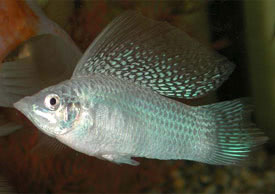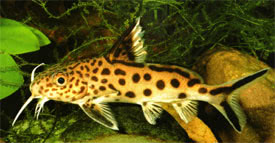
 Magyarul / Hungarian
Magyarul / Hungarian




- Scientific name: Xiphophorus maculatus
- Common name: Platy, Topsail or Rainbow platy, Moonfish
- Group: Livebearers
- Habitat: Central America; Mexico
- Size: Males:3-5 cm, females:4-6 cm
- Biotope: Inhabits rivers on the Atlantic slope of Central America
- Social behavior: A peaceful community fish. Adults may consume fry, although not as often as other Xiphophorus species.
- Diet: Flakes, small pellets, occasionally algae, live, insects, insect larvae , worms, brineshrimp
- Breeding: Easy
- Tank: Minimum 50 litres
- Population: 10-12 fishes for 100 litre
- Decoration: Thick vegetation.
- Temperature: 24-28 °C
- pH: 7-8
- Hardness: 10-20 NK°
- Lifespan: 3 years
Description: Some specimens are elongated with both Dorsal and Ventral profiles slightly curved out or convex, but mostly they are thick-bodied with a high back. The Dorsal fin has nine or ten fin rays, except for the high-fin varieties. They resemble the less seen X. variatus. The females are larger reaching a length of two and one half inches and the males top out at one and one half inches.
The original wild form was a plain grayish brown to olive color, showing a slight sparkle. There were also salt and pepper markings scattered over the body. The many wild varieties have been crossbred and combined so often, the range of colors and fin shapes is almost unlimited with variations showing up almost on a monthly basis.
Varieties that have remained popular in the hobby include the Red-Wag-tail Platy, Tuxedo Platy and many variations on the high fin theme.
An easily cared for fish that does well in all types of community aquaria. Give them a fairly large tank with live plants and open swimming areas, avoid too much driftwood as a rule the livebearers do not like acidic water. Although not a schooling fish they benefit by being kept with a large number of their own kind. Temperature range from sixty-eight to seventy-seven degrees
As the male matures the Anal fin develops into a structure for reproduction called the Gonopodium. The Gonopodium can be moved in almost any direction and stores the sperm in packs called spermatophores. Once the sperm is inserted into the female it fertilizers her eggs and the rest is stored in the Oviduct walls for later use. The eggs are very rich in yolk and the young develop by consuming their yolk stores. In light colored females pregnancy can be recognized by the growing dark body marking in front of the Anal fin.
Young Live-bearers are fairly large at birth and their development is very advanced. They can swim right away, which is needed to avoid their enemies including their parents who give no natal care whatsoever. The fry grow very rapidly and will eagerly accept fine flake food.


























